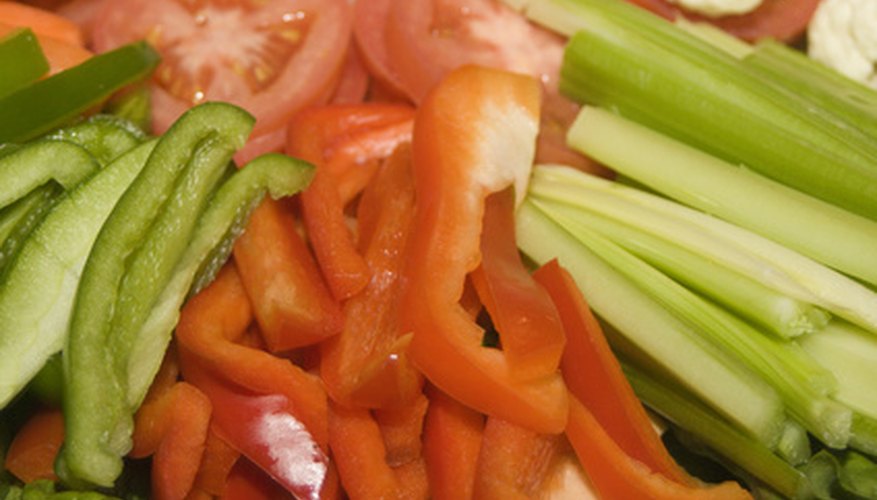Dozens of vegetables can be eaten raw. Vegetables for salads, dips, sandwiches, and those juiced are eaten raw most frequently. Although some raw vegetables provide higher nutrients, if you have trouble digesting raw vegetables, stay with those that are cooked. Everyone should avoid eating raw beans, peas, sweet potatoes and other starchy vegetables.
Raw Salad Vegetables
The largest numbers of raw salad vegetables are consumed at lunch and dinner. Home lunch and dinner salads may be selected from raw vegetables like tomatoes, lettuces, cucumber and spring onions, whereas restaurant dinner and lunch salads include those vegetables, along with others such as alfalfa sprouts, bean sprouts, bell pepper, Bermuda onion (sweet red onion), broccoli flowerets, Swiss chard, chives, leeks, mushrooms, parsley and spring onions.
A good way to know what raw vegetables to add to your diet is to visit a soup and salad restaurant or a South America steakhouse. Both restaurant types are a raw vegetable lover's paradise. Soup and salad restaurants usually offer a larger selection of raw veggies than restaurants where the entrée is the main focus. Soup and salad restaurants may add radishes, shredded carrots and cabbage, spinach and zucchini to the traditional salad vegetable list.
- The largest numbers of raw salad vegetables are consumed at lunch and dinner.
- Soup and salad restaurants usually offer a larger selection of raw veggies than restaurants where the entrée is the main focus.
The South America steakhouses that have sprang up across the U.S. in the past decade offer, in addition to all the customary raw vegetables, arrays of kohlrabi, pea shoots, radicchio, Salad Burnet (edible leaves that smell and taste like cucumber), rutabaga, scallions, shallots and mangetout, spread over large three and four-tiered tables.
Raw Vegetables and Dips
Today's party and snack tables have either eliminated the heaping bowls of crisps and other dipping chips or include trays of bite-sized raw vegetables alongside them. Broccoli, celery stalks, baby carrots, cauliflower, eggplant and zucchini stalks, red and yellow peppers, yellow squash and radishes are among those used to scoop up dips. Some dips themselves (guacamole, salsa, pico de gallo) are made of raw vegetables.
Raw Sandwich Vegetables
Many cooked meat sandwiches wouldn't hold up to a taste test without the addition of raw vegetables. Think of a hamburger without lettuce, onions and sliced tomatoes. Nothing wakes up a chilli dog like chopped onion, or can give a baked potato pizazz like chives. Coleslaw made from shredded cabbage or shredded broccoli stalks complements barbecue, fried chicken and fried seafood dinners. Alfalfa and bean sprouts add that needed crunch to chicken and tuna salad sandwiches.
- Many cooked meat sandwiches wouldn't hold up to a taste test without the addition of raw vegetables.
- Alfalfa and bean sprouts add that needed crunch to chicken and tuna salad sandwiches.
Raw Vegetable Juices
Health juices and cocktails made from raw vegetable and fruit juices are becoming increasingly popular. Raw vegetable juice concoctions are not only made at home, but in juice bars that have sprouted up in grocery stores, shopping malls and other high-foot-traffic areas. Beets, beet greens, celery, celery root, chicory, watercress and dandelion greens are among some of the most popular juiced raw vegetables. Others include escarole, kale, parsnips, rhubarb, tomatoes, carrots and broccoli greens.
- Health juices and cocktails made from raw vegetable and fruit juices are becoming increasingly popular.
- Beets, beet greens, celery, celery root, chicory, watercress and dandelion greens are among some of the most popular juiced raw vegetables.
